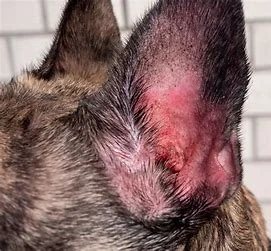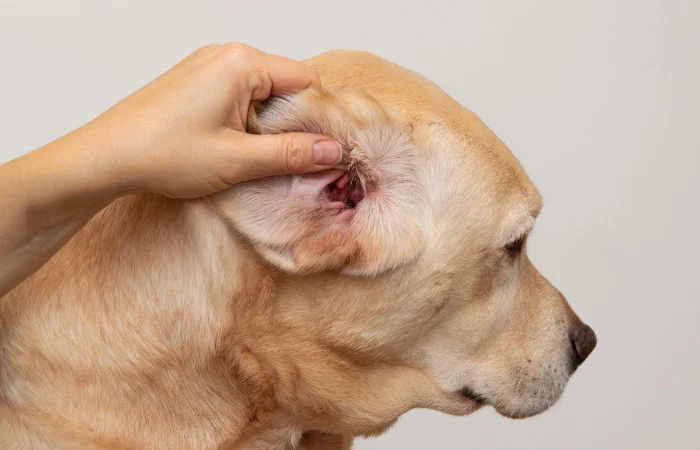Your dog’s ears, those floppy or perky appendages that lend character to their appearance, also play a vital role in their overall well-being.
Proper ear care is more than just a cosmetic concern—it’s an essential part of ensuring your dog’s comfort and health.
From identifying potential issues to effective cleaning techniques, let’s delve into the world of ear care for your beloved canine friend.
Breeds Prone to Ear Problems: Understanding the Why and Who
When it comes to our canine companions, some breeds have a higher predisposition to ear problems than others.
Understanding why certain breeds are more susceptible to these issues can help us take proactive measures to ensure their ear health. Let’s explore the connection between ear problems and genetics, along with a list of breeds and the ear-related issues they’re most prone to:
Why Certain Breeds are Prone to Ear Problems
Genetics and ear anatomy play a significant role in determining a dog’s susceptibility to ear problems. Several factors contribute to this vulnerability:
Ear Shape: Dogs, with floppy ears, are more prone to ear problems because their ears tend to trap moisture. Moist environments create an ideal breeding ground for bacteria and yeast.
Hair Growth Patterns: Breeds with hairy ear canals, have a higher likelihood of accumulating debris and earwax. This can block airflow and provide a breeding ground for infections.
Ear Canal Length: Breeds with long, narrow ear canals are prone to trapping debris, making them susceptible to infections.
Skin Folds: Dogs with excessive skin folds, like Bulldogs and Shar-Peis, can experience trapped moisture and increased friction, leading to irritation and infection.
Breeds Prone to Ear Problems and Common Issue
Cocker Spaniel: Known for their luxurious, floppy ears, Cocker Spaniels are highly susceptible to ear infections due to poor air circulation within their ear canals.
Basset Hound: With their long, droopy ears, Basset Hounds are prone to trapping moisture, leading to infections and discomfort.
Poodle: The dense hair growth in Poodles’ ear canals can trap debris and moisture, making them prone to ear infections.
Shih Tzu: The long hair around Shih Tzus’ ears can easily obstruct airflow, creating a conducive environment for infections.
German Shepherd: Their long, narrow ear canals can trap dirt and debris, making German Shepherds susceptible to infections.
Bulldog: Bulldogs’ adorable wrinkles and skin folds can accumulate moisture and bacteria, leading to infections.
Labrador Retriever: While not as prone as some breeds, Labradors can still develop ear problems due to their love for water and floppy ear structure.

Taking Proactive Steps For Your Dog's Ear Health
Knowing your dog’s breed-specific vulnerabilities is the first step in ensuring their ear health.
Regular ear cleaning, drying their ears after swimming or baths, and regular veterinary check-ups can go a long way in preventing ear problems.
If you have a breed prone to ear issues, make ear care an integral part of your grooming routine to keep their ears comfortable and infection-free.
Remember, while genetics may increase the risk, proper care and attention can significantly reduce the impact of ear problems on your beloved furry friend.
Recognizing Symptoms of Ear Infections in Your Dog: A Quick Guide
As a responsible pet owner, being attuned to your dog’s well-being is paramount, especially when it comes to detecting potential ear infections.
These infections can be uncomfortable for your furry companion, but the good news is that they are often manageable if caught early. Here’s a comprehensive guide to recognizing symptoms of ear infections in your dog and taking prompt action:
- Excessive Scratching or Pawing
If you notice your dog frequently scratching or pawing at their ears, it could be a telltale sign of an ear infection. Irritation or discomfort caused by infection leads dogs to try to relieve the itching, which often exacerbates the issue.
- Head Shaking
Does your dog suddenly shake their head as if they’re trying to dislodge something? While the occasional head shake is normal, persistent shaking or a sudden increase in frequency might indicate an ear problem.
- Four Odor
A foul or unpleasant odor emanating from your dog’s ears could signal an infection. The odor is often a result of the buildup of bacteria or yeast within the ear canal.
- Redness or Inflammation
Inflamed, red, or swollen ear tissue is a visual indicator of an underlying issue. Redness can be caused by irritation, inflammation, or the body’s immune response to infection.
- Discharge
Any discharge from the ears, whether it’s brown, yellow, or bloody, is a clear indication that something is amiss. Ear infections can cause a variety of discharges, and their color and consistency can provide clues about the nature of the infection.
- Sensitivity to Touch
When your dog displays sensitivity or discomfort when their ears are touched, it’s a sign that their ears are bothering them. This behavior may also indicate pain or inflammation within the ear canal.
What Can You Do About It?
If you notice any of these symptoms in your dog, it’s essential to take proactive steps to address the issue:
1. Gentle Examination: Start by gently examining your dog’s ears. Look for redness, swelling, discharge, or any visible signs of irritation. Be cautious, as poking or prodding can cause more discomfort.
2. Consult Your Veterinarian: If you suspect an ear infection, consult your veterinarian. They can perform a thorough examination, including looking deep into the ear canals and taking swabs to diagnose the problem accurately.
3. Avoid Self-Treatment: While it might be tempting to use over-the-counter solutions, avoid self-treatment. Improperly cleaning or medicating your dog’s ears can worsen the issue. Your vet will recommend the appropriate treatment based on the diagnosis.
4. Follow Treatment Plan: If your dog is diagnosed with an ear infection, follow your veterinarian’s treatment plan diligently. This may involve cleaning, medication, and regular follow-up appointments.
5. Preventive Measures: To minimize the risk of future ear infections, practice routine ear cleaning, dry their ears thoroughly after swimming or baths, and maintain regular grooming and health check-ups.
Remember, early detection and swift action can spare your dog unnecessary discomfort and prevent complications. Your dog’s ear health is a crucial part of their overall well-being, so be vigilant and responsive to any changes in their behavior or appearance. Your furry friend will appreciate your care and attention.
Proper Ear Cleaning Techniques
Regular ear cleaning is a proactive step in preventing ear infections and maintaining ear health. To clean your dog’s ears, follow these steps:
Gather Supplies: You’ll need ear cleaning solution, cotton balls, and a towel.
Choose the Right Solution: Opt for a veterinarian-recommended ear cleaning solution that is safe for your dog’s ears.
Apply the Solution: Gently lift your dog’s ear flap and fill the ear canal with the cleaning solution.
Massage and Wipe: Gently massage the base of the ear to distribute the solution. Let your dog shake their head to dislodge debris. Use a cotton ball to wipe away excess solution and dirt.
Repeat the process on the other ear.
Dry Thoroughly: Use a dry cotton ball or towel to gently dry the ears.
NOTE: Do not clean your dog’s ears if it is showing any of the symptoms listed above, as it could make the problem much worse. Always seek veterinary care first.
Product Options for Ear Cleaning and Health
Maintaining your dog’s ear health is a crucial aspect of responsible pet ownership. Fortunately, there’s a range of products designed to help you keep your furry friend’s ears clean and free from potential infections.
Here’s a quick guide to the various product options available:

Ear Wipes
Ear wipes are convenient and easy-to-use products designed to gently clean the external parts of your dog's ears. These wipes are pre-moistened with a mild solution that helps remove dirt, debris, and excess wax. They are particularly useful for routine cleaning between deeper cleanings.

Ear Cleaning Solutions
Ear cleaning solutions are specially formulated liquids that aid in breaking down and loosening wax and debris within the ear canal. These solutions are usually applied to a cotton ball or gauze pad, which is then used to clean the visible part of the ear canal.

Ear Drying Agent
Drying agents maintain a dry environment within your dog's ears, which can prevent the growth of bacteria and yeast. This is particularly beneficial after swimming or bathing, as excess moisture can contribute to ear infections. Drying agents contain ingredients that help evaporate moisture.

Ear Powder
Ear powder helps to grip excess hair within your dog's ears. It can make the plucking process more manageable and comfortable for your dog. However, using ear powder requires expertise, so consult your veterinarian or a professional groomer before attempting to pluck your dog's ears.

Prescription Medications
In cases of more severe ear infections or chronic issues, your veterinarian may prescribe specific medications, such as antibiotics or antifungal drops. These medications are tailored to your dog's specific condition and should be administered as directed by your veterinarian.
Before selecting any products for your dog’s ear care, it’s essential to consult your veterinarian. They can provide personalized recommendations based on your dog’s breed, ear structure, health history, and any existing ear issues.
What works for one dog may not be suitable for another, so professional guidance is pretty important. And, after all, they went to years of school for this!
Using Ear Care Products Safely
Now that you know the options available to you, let’s discuss how to safely use them!
Read Instructions: Carefully read and follow the instructions provided by the manufacturer. Improper use can lead to discomfort or even exacerbate existing ear issues.
Avoid Q-tips: Never insert cotton swabs or Q-tips into your dog’s ear canal. These can push debris deeper into the ear or cause damage to the sensitive ear structures.
Be Gentle: When cleaning your dog’s ears, be gentle and avoid using excessive force. If you encounter resistance or your dog displays discomfort, stop and consult your veterinarian.
Regular Maintenance: While some breeds require routine ear cleaning, others do not. Consult your veterinarian to determine the appropriate frequency and methods for ear cleaning based on your dog’s individual needs.
Common Ear Problems for Dogs and Their Symptoms
Being attuned to your dog’s health and well-being includes understanding the potential ear problems they might encounter.
While proper ear care can prevent many issues, it’s essential to recognize the signs of common ear problems, so you can take swift action.
Here’s a comprehensive overview of some prevalent ear problems and their associated symptoms, along with, at times, disgusting photos:
Otitis Externa
Otitis externa refers to the inflammation of the external ear canal. This condition can be caused by allergies, moisture buildup, foreign bodies, or infections.

The symptoms of otitis externa include:
- Pain and Discomfort: Dogs with otitis externa often exhibit signs of pain, such as pawing at their ears, head shaking, and rubbing their heads against objects.
- Redness and Inflammation: The affected ear may appear red, swollen, or inflamed.
- Discharge: You might notice discharge from the ear, which can range from clear to yellow or brown.
- Odor: In some cases, a foul odor may emanate from the ear canal.
- Hearing Loss: As the inflammation progresses, your dog might experience temporary hearing loss.
Ear Mites (Otodectes Cynotis)
Ear mites are tiny parasites that can infest your dog’s ear canal, leading to significant discomfort.

The symptoms of an ear mite infestation include:
- Intense Itching: Dogs with ear mites often scratch their ears vigorously and may also rub their heads on surfaces.
- Dark Discharge: The presence of ear mites can cause a dark, coffee-ground-like discharge within the ear canal.
- Crusty Debris: The ear may accumulate crusty debris, resembling dried blood or coffee grounds.
Yeast Infections
Yeast infections in dogs’ ears are often caused by an overgrowth of Malassezia yeast.

The symptoms of a yeast infection include:
More To Discover
- New Pup on the Block: Ultimate Guide To Introducing Your New Puppy To Your Older Resident Dog (Helpful Examples Included)
- Can Dogs Drink Oat Milk? Here’s What You Need to Know
- Dog First Aid: Essential Skills, Techniques, and Kit Every Dog Owner Should Know
- The Importance of Your Pet’s Dental Health: More Than Just a Winning Smile
- Foul Odor: One of the hallmark signs of a yeast infection is a noticeable, unpleasant odor emanating from the ear.
- Itching: Dogs with yeast infections frequently scratch or paw at their ears due to itching.
- Discharge: The discharge associated with yeast infections is often brown or yellow and may resemble cottage cheese in texture.
- Head Tilting: Your dog might tilt their head to one side, indicating discomfort in the affected ear.
Always prioritize your dog’s comfort and safety when caring for their ears, and don’t hesitate to reach out to your veterinarian for advice and recommendations.
Your diligence and care will contribute to your furry friend’s happy and healthy life.
Remember, your veterinarian is your greatest ally in ensuring your dog’s ears remain a source of joy rather than discomfort.
























